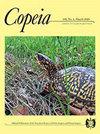珍稀濒危Teays河特有种舌鱼(Exoglossum laurae)的水系历史、演变与保护
IF 2.6
Q2 Agricultural and Biological Sciences
引用次数: 3
摘要
古代河流系统的遗产往往表现为水生物种的遗传多样性模式。古提斯河是美国东部的主要河流,在更新世之前和更新世期间,它与邻近的古河流有过几次短暂的联系,当时周期性的冰川前进和后退重新配置了该地区的河流系统。本研究分析了舌结鲦鱼(Exoglossum laurae)的一个线粒体(mtDNA)和三个单拷贝核DNA (scnDNA)位点的DNA序列多样性,舌结鲦鱼(Exoglossum laurae)是一个分布在大迈阿密河上游、阿勒格尼河上游、Genesee河上游和新河流域的四个不相连种群。线粒体DNA变异表明,新河拥有最高的多样性(h = 0.73),舌系鲦鱼由两个古老的谱系组成,一个Teays河谱系和一个匹兹堡河谱系。对scnDNA位点的分析显示,在laurae种群中,以及在Roanoke河和Potomac河取样的舌纹米诺与其唯一的同系者Cutlip Minnow (E. maxillingua)之间,等位基因是共享的。据估计,新河和上Genesee河种间杂交的概率分别为0.16和0.34,但可能是某种程度上不完整的谱系分类导致了这些估计。在Roanoke河和Potomac河中,Cutlip Minnow的种间杂交概率分别为0.62和0.65,这可能反映了Teays河流域的河流捕获事件导致的古代杂交。管理策略应侧重于维护大迈阿密河上游和阿勒格尼河上游流域匹兹堡河流域的安全。最后,关于舌结米诺相当复杂的分类历史的见解很少,但是遗传变异与大迈阿密河上游流域舌结米诺的亚种地位不一致。本文章由计算机程序翻译,如有差异,请以英文原文为准。
Drainage History, Evolution, and Conservation of Tonguetied Minnow (Exoglossum laurae), a Rare and Imperiled Teays River Endemic
Legacies of ancient riverine systems are often manifest in patterns of genetic diversity within aquatic species. The ancient Teays River, a principal drainage of the eastern United States, engaged in several ephemeral connections with neighboring palaeodrainages prior to and during the Pleistocene, when cyclical glacial advance and retreat reconfigured the region's fluvial systems. This study assayed DNA-sequence diversity at one mitochondrial (mtDNA) and three single-copy nuclear DNA (scnDNA) loci from the Tonguetied Minnow (Exoglossum laurae), a species distributed as four disjunct populations, one each within the Upper Great Miami, Upper Allegheny, Upper Genesee, and New rivers. Mitochondrial DNA variation revealed that the New River harbors the highest diversity (h = 0.73) and that the Tonguetied Minnow is composed of two ancient lineages, a Teays River lineage and a Pittsburgh River lineage. Analyses of the scnDNA loci revealed sharing of alleles among populations of E. laurae and between the Tonguetied Minnow and its only congener, the Cutlip Minnow (E. maxillingua), sampled from the Roanoke and Potomac rivers. The probability of interspecific hybridization in the New and Upper Genesee rivers was estimated as 0.16 and 0.34, respectively, but it is likely that some degree of incomplete lineage sorting contributed to these estimates. Probabilities of interspecific hybridization for Cutlip Minnow were 0.62 and 0.65, for the Roanoke and Potomac rivers, respectively, and might reflect ancient hybridization resulting from stream capture events involving these drainages by the Teays River. Management strategies should focus on maintaining the security of the Pittsburgh River lineage in the Upper Great Miami and Upper Allegheny River drainages. Finally, insights into the Tonguetied Minnow's rather convoluted taxonomic history are few, but genetic variation is inconsistent with subspecies status for Tonguetied Minnow in the Upper Great Miami River drainage.
求助全文
通过发布文献求助,成功后即可免费获取论文全文。
去求助
来源期刊

Copeia
生物-动物学
CiteScore
2.10
自引率
0.00%
发文量
0
审稿时长
6-12 weeks
期刊介绍:
Founded in 1913, Copeia is a highly respected international journal dedicated to the publication of high quality, original research papers on the behavior, conservation, ecology, genetics, morphology, evolution, physiology, systematics and taxonomy of extant and extinct fishes, amphibians, and reptiles. Copeia is published electronically and is available through BioOne. Articles are published online first, and print issues appear four times per year. In addition to research articles, Copeia publishes invited review papers, book reviews, and compiles virtual issues on topics of interest drawn from papers previously published in the journal.
 求助内容:
求助内容: 应助结果提醒方式:
应助结果提醒方式:


